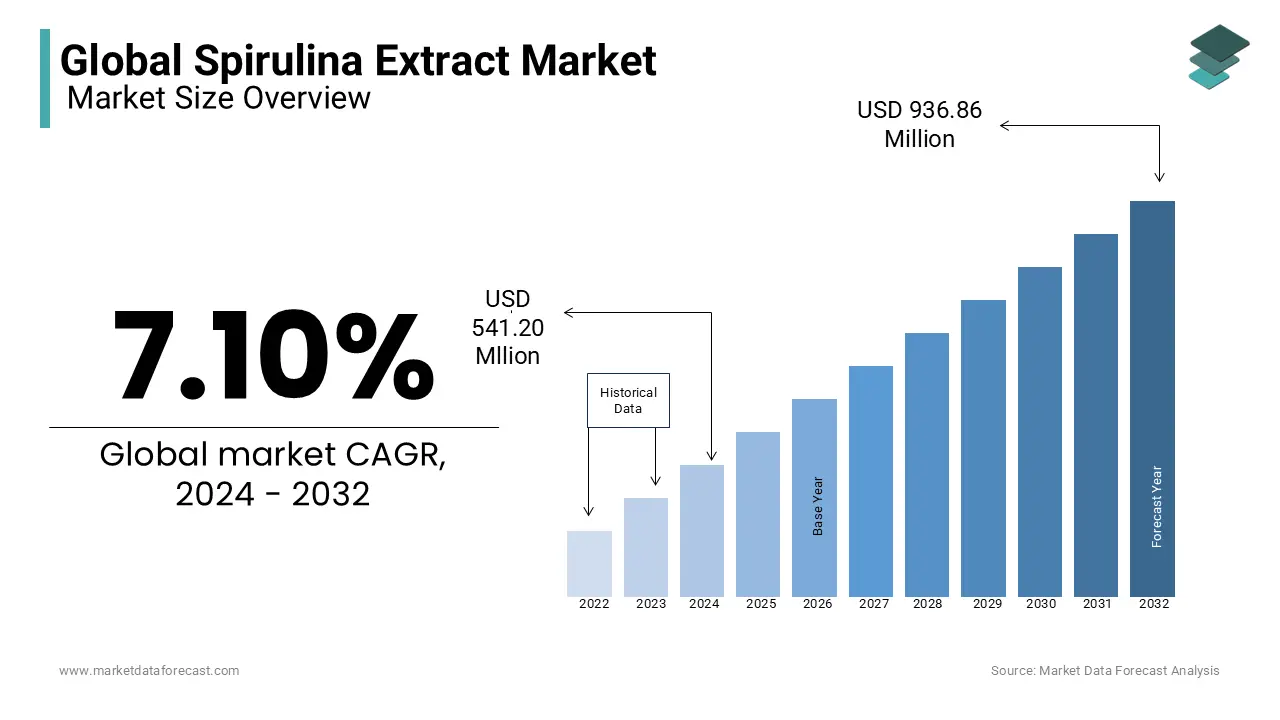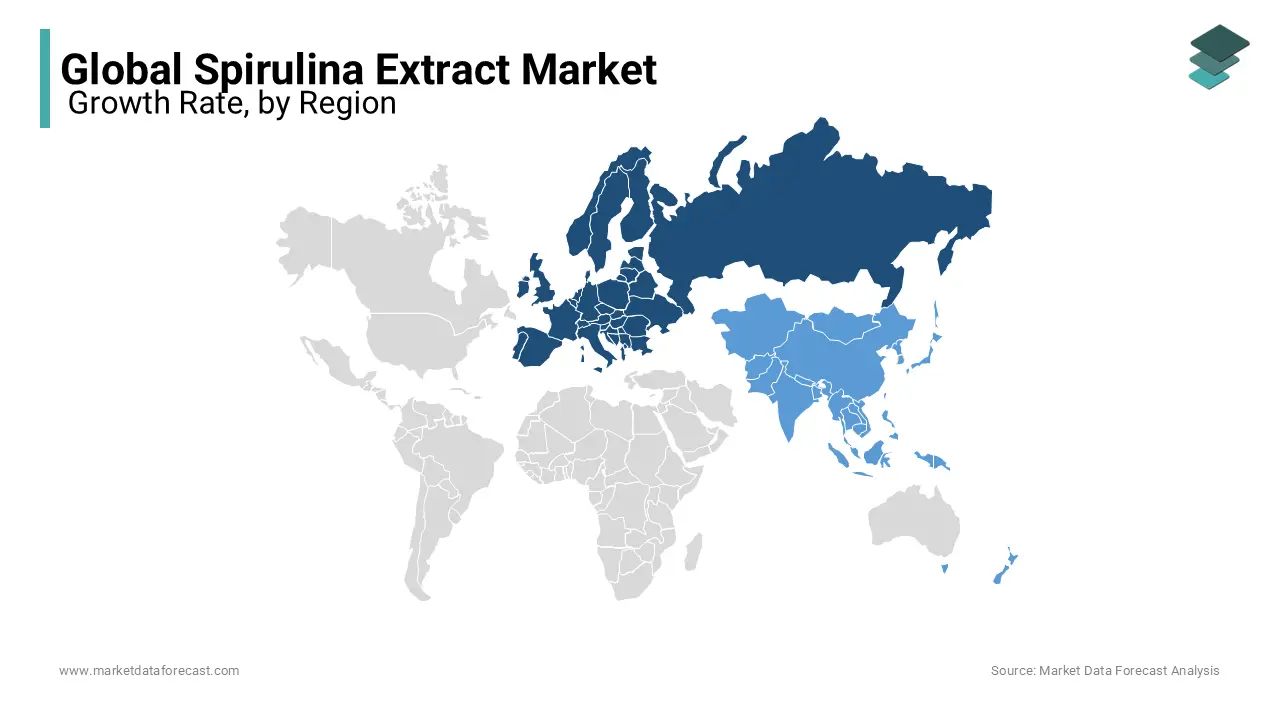Global Spirulina Extract Market Size, Share, Trends & Growth Forecast Report - Segmented By Application (Dietary Supplements & Nutraceutical, Confectionery, Cosmetic, Bio-Fertilizer And Aquaculture Feed), Form (Powder, Liquid) , And Region(North America, Europe, Asia-Pacific, Latin America, Middle East And Africa) - Global Industry Analysis, Size, Share, Growth, Trends And Forecast 2025 To 2033
Global Spirulina Extract Market Size
The size of the global spirulina extracts market was expected to be worth USD 541.20 million in 2024 and is anticipated to be worth USD 1.003 billion by 2033 from USD 579.63 million In 2025, growing at a CAGR of 7.10% during the forecast period.

MARKET DRIVERS
Spirulina is a drum-dried cyanobacterium (blue-green algae) consumed by humans which are made primarily from two species of cyanobacteria: Arthrospira platensis and Arthrospira maxima.
Spirulina has very high protein content, considerably low in calories and cholesterol, and high in enzymes, minerals (sodium, iron, calcium, and magnesium), and phenolic acids, that have antioxidant properties. Spirulina also has very high levels of beta-carotene, a natural antioxidant, which the body converts to vitamin A and plays a protective role in the human body. Performance and stamina levels are elevated when Spirulina is taken as a sports supplement. In the past two and a half-decade Spirulina few nutrition specialists have recommended Spirulina nutrition against difficult diseases like liver disorders, allergic reactions, oral cancer and many more. This claim is also corroborated by both National Aeronautics and Space Administration (NASA) and the European Space Agency (ESA) which are analysing Spirulina as one of the key foods for long-term space missions or in case of colonization of other planets. Studies have shown that spirulina can lower cholesterol levels, stimulate the immune system and be effective in the treatment of heart disease, premenstrual stress, obesity, arthritis, anaemia and osteoporosis. Spirulina powder has great use in the dairy industry to substitute synthetic additives viz., colours, stabilizers and emulsifiers etc., employed in various dairy products.
Spirulina is easily digestible high protein product with high levels of β-carotene, vitamin B12, iron and trace minerals and the rare vital fatty acid γ-linoleic acid (GLA). Additionally, it has no religious issues or negative cultural regarding its consumption. Its production is eco-friendly, very efficient in terms of land occupation, water use and energy consumption in contrast to traditional terrestrial crops. Its production is particularly suitable to saline and alkaline conditions which are often unfavourable to traditional crops and are often occupied by disadvantaged people vulnerable to natural disasters. Its manufacture can be done at a number of different levels, from household “pot culture” to intensive commercial development over large areas. It can be integrated with rural organic waste treatment processes to improve both energy transfer efficiencies and environmental conditions. These advantages are the primary factors driving the growth of this market. Moreover, rising consumer awareness for natural food in contrast to synthetic food conjoined with health-promoting properties of natural food colours as well as the growing demand for clean label products and savoury government regulations like FDA’s approval to use spirulina to impart blue colour in candy in U.S. as an alternative to synthetic FD&C Blue#1 are the secondary factors fuelling the growth of this market.
MARKET RESTRAINTS
The most commonly reported negative effects are muscle pain, flushing of the face, headache, sweating, and difficulty concentrating.
People who have the metabolic disorder phenylketonuria should avoid this product. It is not recommended for people who are allergic to seaweed or seafood. Very little is known about its effects during pregnancy and breast feeding. These are the primary factors hindering the growth of this market. Blue-green algae harvested in uncontrolled culture conditions may be contaminated with heavy metals that can lead to liver damage, diarrhoea and vomiting. Furthermore, higher cost associated with the production of natural colours in comparison to the synthetic colours along with their unstable nature are the secondary factor responsible for a sluggish market growth.
REPORT COVERAGE
|
REPORT METRIC |
DETAILS |
|
Market Size Available |
2024 to 2033 |
|
Base Year |
2024 |
|
Forecast Period |
2025 to 2033 |
|
CAGR |
7.10% |
|
Segments Covered |
By Form, Application, and Region |
|
Various Analyses Covered |
Global, Regional & Country Level Analysis; Segment-Level Analysis, DROC, PESTLE Analysis, Porter’s Five Forces Analysis, Competitive Landscape, Analyst Overview of Investment Opportunities |
|
Regions Covered |
North America, Europe, APAC, Latin America, Middle East & Africa |
|
Market Leaders Profiled |
DDW The Color House, Sensient Technologies Corporation, Chr. Hansen A/S, and DIC Corporation |
SEGMENTAL ANALYSIS
Global Spirulina Extracts Market Analysis By Form

In 2016, powder segment lead the market in terms of revenue share contribution and is further projected to remain dominant during the aforementioned forecast period. This is due to growing usage of powder form in products for example, bakery, confectionery and desserts. Spirulina extract is commercially being utilized for large scale manufacture of blue colour in food and beverages, in which powdered formulation suits the best in contrast to the liquid extract. Rising applications of spirulina extract as dietary supplement among consumers is further encouraging its adoption as a dietary supplement in liquid form, thus resulting in significant growth of liquid segment in the market. Moreover, liquid spirulina extract utilization in beverages is likely to increase considerably, thus resulting in extensive R&D among manufacturers. Liquid extracts are more stable and advantageous as compared to powder extract and are likely to capture more market share in the forecast period.
Global Spirulina Extracts Market Analysis By Application
Dietary supplements and nutraceutical category commanded the market followed by bio-fertilizer and aquaculture feed category. Bio-fertilizer and aquaculture feed category collectively commanded 45% of the total spirulina extract market contribution in 2016.
REGIONAL ANALYSIS

In 2016, Europe was the leading market followed by North America and Asia Pacific. Asia Pacific and North America commanded 50% market share. Market growth in Europe is fuelled by factors like research and development for better formulations especially for confectionery products, ban on artificial colors application, compliance with European regulations and others. Additionally, The United States FDA approval for spirulina as a colouring agent in varied food and beverage applications improves market in North America. Rising demand for spirulina extracts from the food and cosmetic industry in North America is also expected to raise the demand for spirulina extracts in this region. Moreover, in Japan compulsory usage of natural food colorants in food and beverages has increased the demand for spirulina extracts, thus spurring growth of spirulina extracts market.
KEY PLAYERS IN THE GLOBAL SPIRULINA EXTRACTS MARKET
Companies operating in the spirulina extracts market are DDW The Color House, Sensient Technologies Corporation, Chr. Hansen A/S, and DIC Corporation
DETAILED SEGMENTATION OF THE GLOBAL SPIRULINA EXTRACTS MARKET INCLUDED IN THIS REPORT
This research report on the global spirulina extracts market has been segmented and sub-segmented based on form, application, and region.
By Form
- Powder
- Liquid
By Application
- Confectionery
- Cosmetic
- Dietary Supplements & Nutraceutical
- Bio-fertilizer
- Aquaculture Feed
By Region
- North America
- Europe
- Latin America
- Asia Pacific
- Middle East and Africa
Frequently Asked Questions
1. What is driving the growth of the spirulina extract market?
The market growth is driven by increasing consumer awareness about health and wellness, rising demand for natural and organic products, and the growing use of spirulina in various industries such as food and beverages, pharmaceuticals, and cosmetics.
2. What are the key market trends in the spirulina extract market?
Key trends include the rising popularity of plant-based diets, increased use of spirulina in functional foods and beverages, and growing investments in research and development for new applications of spirulina extract.
3. What is the future outlook for the spirulina extract market?
The future outlook is positive, with expected growth driven by increasing health awareness, the trend towards natural and organic products, and the expansion of spirulina applications in various industries. Technological advancements and sustainable production practices will also play a crucial role.
Related Reports
Access the study in MULTIPLE FORMATS
Purchase options starting from
$ 2500
Didn’t find what you’re looking for?
TALK TO OUR ANALYST TEAM
Need something within your budget?
NO WORRIES! WE GOT YOU COVERED!
Call us on: +1 888 702 9696 (U.S Toll Free)
Write to us: sales@marketdataforecast.com